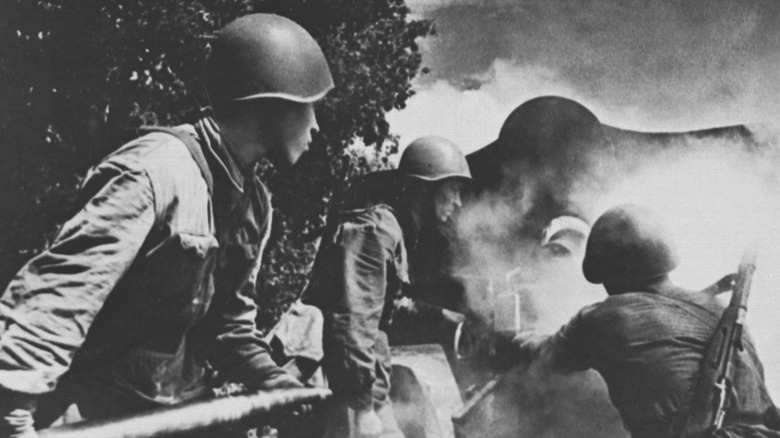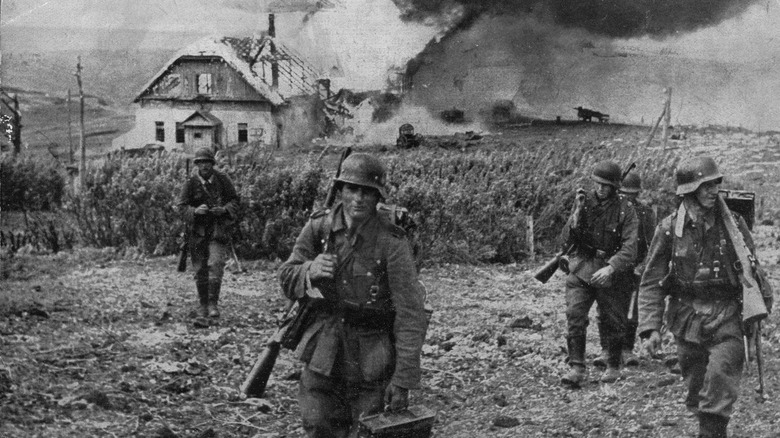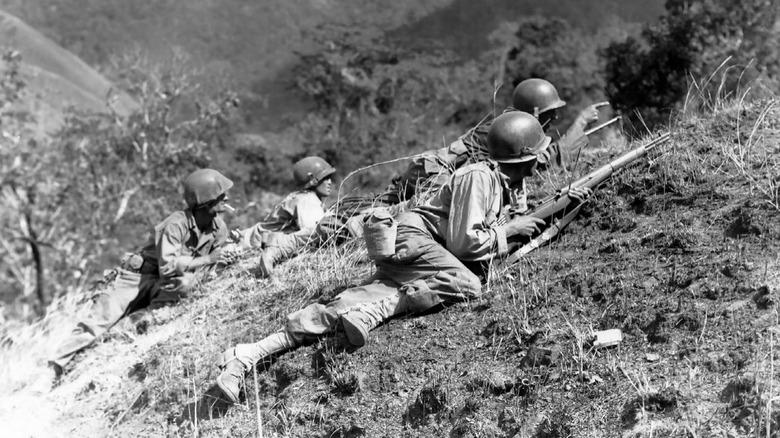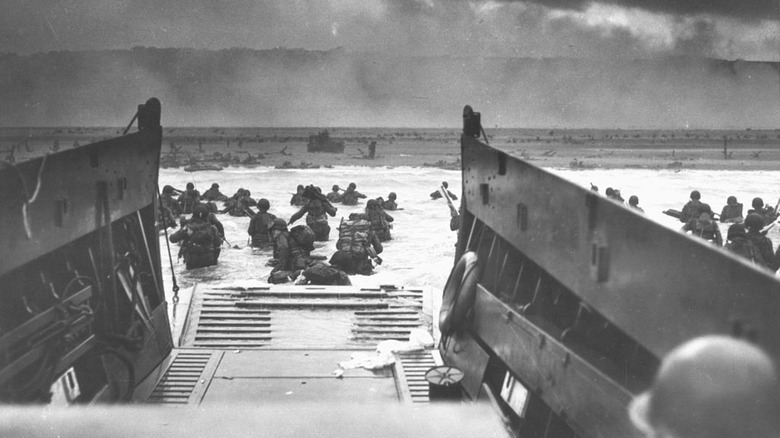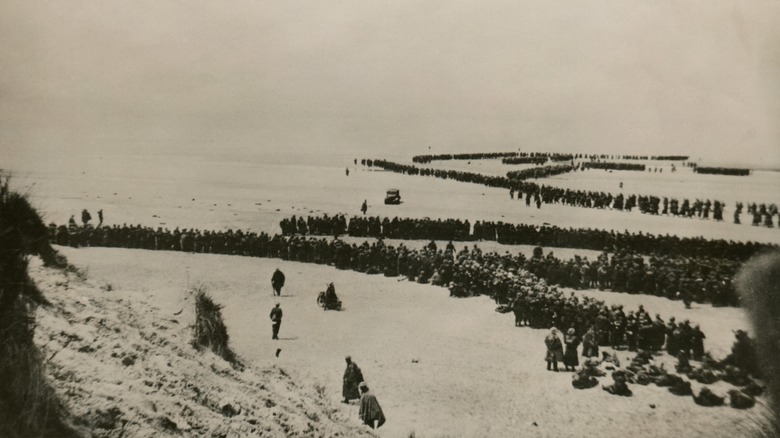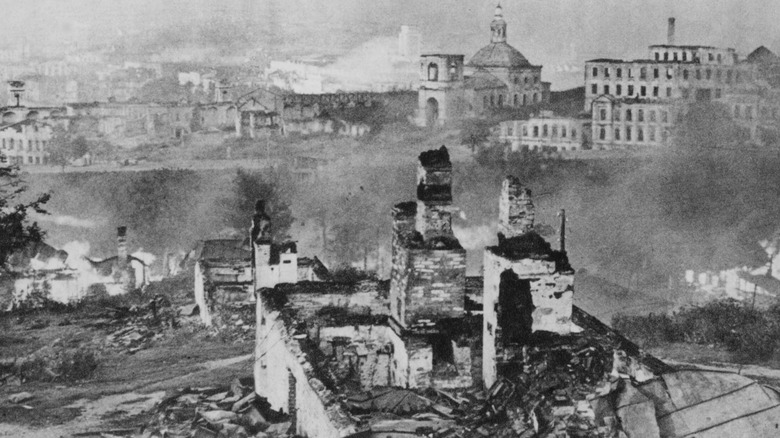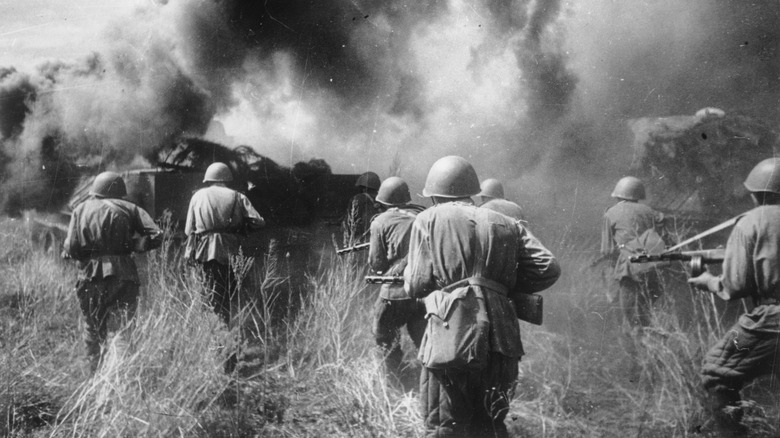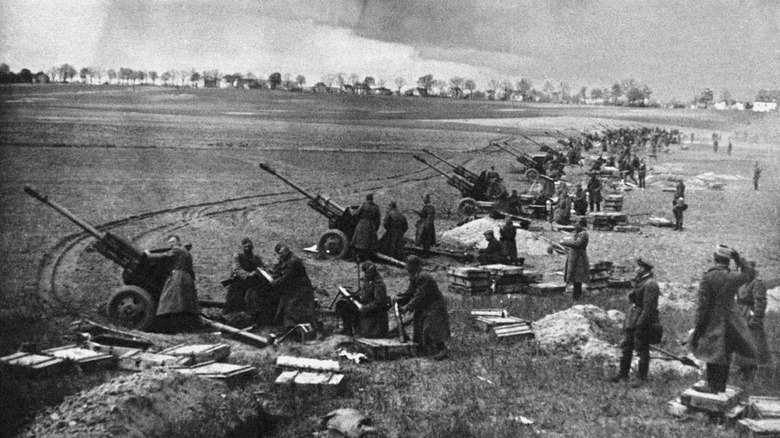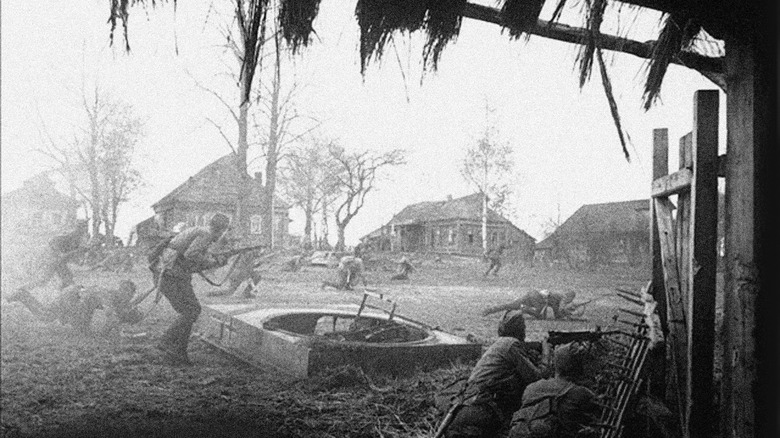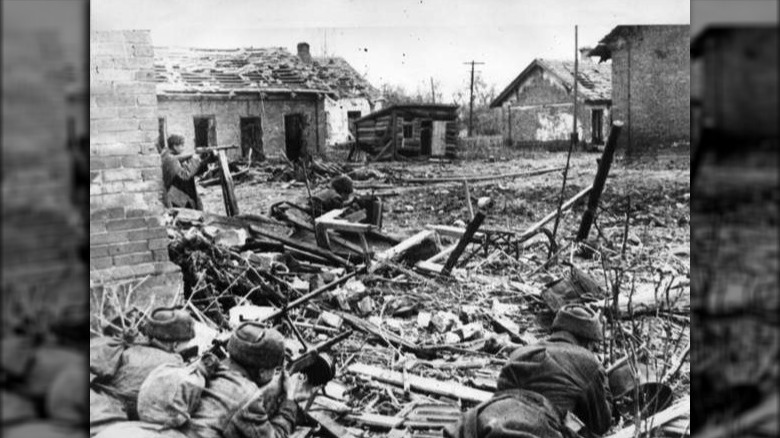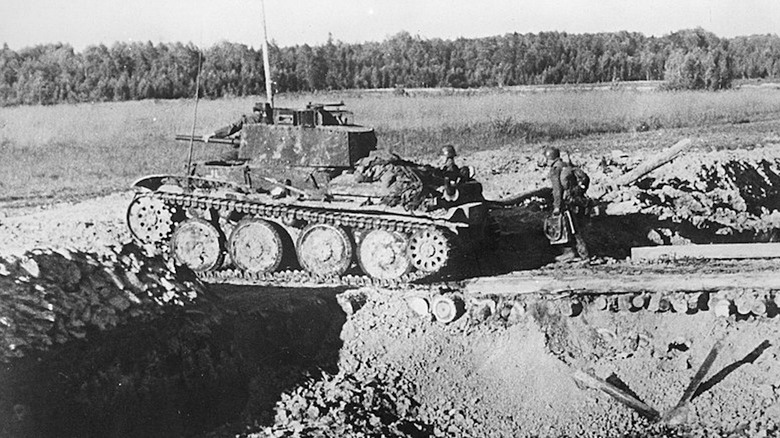Deadliest Battles Of World War II
World War II was bloody. As in, impressively and tragically so — the numbers are absolutely staggering. Somewhere around 15 million people were killed in battle, and potentially three times as many civilian deaths, per The National WWII Museum. Of course, everything is kind of an estimate at this point, but the numbers are still ridiculous to think about — 60 million deaths, maybe even more. With that in mind, it follows that over the course of the war, there were be some particularly bloody battles. And, well, that's exactly the case. Plenty of battles saw casualty counts in the hundreds of thousands; the rare occasion even saw numbers breaking well past a million.
That said, determining the deadliest battles of the war is actually sort of a tricky business. The actual definition of what counts as a "battle" is really hazy — sieges and large-scale operations were also a thing. So, we'll be looking at the individual battles within larger operations rather than a whole operation and pretty much just cutting out sieges (so no Siege of Leningrad, in case you were wondering). Also, casualty counts are all estimates but usually count more than deaths; it's hard to know if someone's dead, captured, or missing in action, and the numbers usually don't specify. And there was another war going on parallel to World War II — the Second Sino-Japanese War — which we aren't including in this list just to simplify things. Anyway, sound good? Let's get going.
The Second Battle of Kharkov — 310,000 casualties
The Battle of Moscow was a definite success for the Soviets in late 1941. They managed to keep the Germans from invading, and in 1942, they felt ready to launch their own offensive, picking the Ukrainian city of Kharkov as their target (via World War II Database).
According to Weapons and Warfare, things actually went pretty well for the Soviets at first. For starters, they managed to punch through the German front, which struggled to survive. By all means, it seemed like a sign of a Soviet victory to come, but both sides agreed to halt the battle for a couple of months due to the weather. Besides, the Soviet army was basically spent and couldn't manage to quite finish the job; they planned to do that when fighting resumed. But so did the Germans, and things ultimately ended up going their way. They got their hands on Soviet intelligence and plans, effectively killing any hope the Soviets had to surprise their enemy. By mid-May, the German Luftwaffe had also arrived, providing powerful air support and easy access to supplies. In contrast, the Soviet army was under-supplied and ill-prepared, all while the upper management failed to, well, manage effectively.
Ultimately, the Soviets couldn't make any moves and eventually found themselves surrounded, fighting for their lives. Casualty counts for the Soviets vary but are somewhere between 200,000 and 280,000. In comparison, the Germans only lost about 30,000.
The Battle of Luzon — 367,000 casualties
A lot of this list is pretty heavy on the European front, so let's take a quick trip across the globe and talk about an especially bloody battle from the Pacific theatre: the Battle of Luzon. Time to head to the Philippines.
The Philippines were captured by the Japanese early in the war, and the United States wanted to take them back. In late 1944, the Allies made their move, starting with the Battle of Leyte Gulf, which eventually allowed them to move toward Luzon in early 1945 (via The Battle of Luzon). There, the Japanese army was split up into multiple groups, each defending different areas, and some locations saw a lot more action than others. According to History, the early part of the invasion of Luzon was actually pretty easy, but that was by design. A huge network of tunnels had been created on the island by the Japanese and allowed them to play defensively, escaping early fights while drawing Allied forces further inland.
Eventually, the fighting did turn really bloody, with certain locations seeing a lot more blood than others. Near the mountains, Japanese forces wore down the Allies over time and caused quite a bit of damage, and the urban environment of Manila didn't favor the Allies either. Without air support in the city, close-range fighting led to a lot of deaths. As in, 137,000 Allied casualties (counting those both in and out of combat) and nearly 230,000 Japanese casualties.
The Battle of Normandy — 425,000 casualties
Everyone's probably heard of this one — that big pivotal turning point of World War II that led to the ultimate fall of Nazi Germany. But it was also the stage for a lot of death.
History explains that after the miraculous evacuation of British and French troops from Dunkirk in 1940, plans for an invasion via the English Channel started taking shape. By 1943, those plans became more serious — enough that the Germans were even aware that such an invasion was a possibility. Not that it was really that much of a problem, as the Allies deceived the Axis with fake radio transmissions and double agents, even convincing them that the invasion would be coming much further north. Hundreds of thousands of men and vehicles landed at Normandy, and on June 6, the Battle of Normandy — or Operation Overlord, or D-Day, depending on what you prefer — truly started. German units were delayed, unorganized, and just outmatched, especially with Allied air support. Although they resisted the Allied advance, they couldn't stop it, and Paris was liberated by August 1944.
The tide of war turned toward the Allies, and the fall of Nazi Germany was just on the horizon, but Normandy wasn't stormed without cost. D-Day Revisited estimates over 425,000 casualties and some 15,000 civilian casualties. Still, it also explains that no one at the time was really invested in keeping an accurate count.
The Battle of France — 523,000 casualties
The beginning of the war was decidedly a low point for the Allied forces, and if you want examples of that, then look no further than the Battle of France. In the years leading up to World War II, France worked to fortify defenses on its shared border with Germany — specifically, the infamous Maginot Line (via History Crunch). But they didn't extend that line to the northernmost point of the border, as the country thought the Ardennes Forest was thick enough to function as a natural defense.
That wasn't true at all. In May 1940, German tanks punched through the trees easily and took the Allies by surprise with their blitzkrieg tactics. To make matters worse, the Germans also launched a diversionary attack further north. According to the Royal Air Force Museum, they occupied some of the strongest Allied units, leaving France painfully ill-defended. Ultimately, British and French forces had to flee north to be saved by a miraculous evacuation from Dunkirk, while the Germans were free to travel south and take Paris with very little resistance.
Of course, Dunkirk would play a very different role later in the war. But in 1940, the situation was dire. "We have been defeated; we have lost the battle" were the words of French Premier Paul Reynaud to Prime Minister Winston Churchill, and that about sums it up. France fell, taking with it 360,000 casualties on the Allied side and 163,000 on the Axis side.
The Battle of Smolensk — over 680,000 casualties
Operation Barbarossa really wasn't an especially good time for the Soviet Union. According to IWM, the campaign centered on Hitler's plan to invade Russia and take over, and the Soviet Union wasn't ready at all.
The Battle of Smolensk was a part of that, albeit not the biggest Soviet loss. As Warfare History Network explains, Smolensk had been historically known for being a "land bridge" to Moscow — a city that opened up the gates to the Russian capital. Obviously, Hitler was interested in taking the city, while Stalin was determined to defend it. German units approached the city, effectively spreading out and surrounding it, and made quick attacks that the Soviets couldn't deal with. They forced themselves into the city, taking over the southern side and pushing the Soviet army up north. And the whole situation wasn't made any better for the Soviets when morale plummeted and many of the men deserted.
Angered by how badly things were going, Stalin ordered a counteroffensive, which led to insanely close-range fighting among the ruins of Smolensk. Although this attack managed to keep the Germans out of the northern part of the city, the Soviets ultimately lost the battle, suffering over 600,000 casualties (German casualties were somewhere around 80,000). But the Battle of Smolensk was successful in something — it slowed the German advance and upset the pace of Operation Barbarossa, helping to keep the fight on the Eastern front alive (via War History Online).
The Battle of Kursk — 1 million casualties
After the Battle of Stalingrad, the Eastern front was getting away from the Germans, so they staged a last-ditch offensive operation to try and salvage their position. According to History Net, this campaign came with the fun name of "Operation Citadel" and would end with the Battle of Kursk — the biggest tank battle ever.
According to History, Germany achieved some victories near Kursk as of March 1943, and it seemed like a chance to regain some level of control. But things didn't really go that way. Although Germans tended to succeed when they had the aspect of surprise on their side (the blitzkrieg was a thing for a reason), they decided to bunker down near a tactical position called the Kursk Bulge and make long-term preparations for a battle against the Soviets. They amassed hundreds of thousands of men, ultimately deciding to postpone their plans to attack. Unfortunately for them, the Soviets made use of their time in the exact same way, putting together a truly massive army (over a million men!), laying down mines, and more.
The battle finally started in July, but it wasn't long before Hitler had to pull troops from the Eastern front to deal with the Allied landing in Sicily. Eventually, the Soviets were able to break down German defenses and win the battle. The costs were high, though, with the Soviets losing up to 800,000 men, and the Germans losing somewhere around 200,000.
The Battle of Berlin — over 1 million casualties
As 1945 rolled around, Nazi Germany was in its final death throes. All that was left was the capture of Berlin, and in April 1945, the Allies (specifically the Soviets) were in the perfect position to start pushing toward the city. The Soviet army reached the German capital and easily trapped opposing forces inside (via ThoughtCo). Oh, and those German soldiers? At least partly made up of men who hadn't originally signed up for military service and had only just been added to the army — in other words, woefully untrained. Needless to say, German defenses didn't hold up well, and the Soviets successfully broke through by storming the headquarters of the Gestapo. From there, everything fell apart quickly for the Germans; Hitler committed suicide, and Germany surrendered on May 7.
Casualties were high — early Soviet reports claimed about 460,000 were killed and almost 480,000 captured (though other reports vary), along with 125,000 civilian casualties. But there might've been a particular reason for that: the Soviets wanted to beat the rest of the Allies to Berlin and take the city on their own. Per History, potential nuclear secrets were on the line. Whoever got to Berlin first could have their hand on nuclear research, which would potentially dictate the new world order. That said, Eisenhower didn't actually try to race to Berlin since haste would likely lead to the loss of more lives. And given the Soviet casualties, he probably had a point.
The Battle of Moscow — 1.7 million casualties
Frankly, Operation Barbarossa — the planned German invasion of the Soviet Union — would probably top this list if it was all considered as one conflict. But seeing as how that's not how we're dealing with things, let's talk about the end of Operation Barbarossa: the plan to take Moscow. Technically called Operation Typhoon, the planned invasion of Moscow and the subsequent battle started in early October 1941. This battle came long after the start of Operation Barbarossa in June of the same year and followed a wave of German military successes.
Per ThoughtCo, waiting on Moscow might've been a bad idea. When German forces arrived at the Soviet capital, winter was just setting in, and the Russian winter is its own issue. The weather wasn't the only problem, though. German forces were weary after months of constant battle, and supplies were scarce. Plus, Soviet forces weren't as surprised as they had been in June. According to IWM, they had prepared for a fight — citizens built defensive lines around the city while a million extra Soviet troops were pulled from elsewhere to defend the capital. Once winter halted German movements, the Soviets launched a counter-offensive that ultimately pushed the Germans over 150 miles away from Moscow.
The Battle of Moscow kept the Eastern Front alive through the war, but that didn't come without a steep cost. Up to 400,000 Germans and nearly 1.3 million Soviets were killed.
The Battle of Stalingrad — 1.9 million casualties
Nearly 2 million deaths. That's the casualty count here. The National Interest explains that things really started the year before — in 1941 — with Hitler's decision to invade the Soviet Union. Stalingrad was a particularly enticing target, being the last roadblock on the path to Nazi occupation of Moscow — a Soviet industrial center, and a symbolic source of pride. Through the first half of 1942, the Nazis made moves through eastern Europe. And according to History, they were knocking on the doors of Stalingrad in late August 1942.
Stalin wasn't about to take a loss so easily, though. He ordered the city's residents to stay and defend it under threats of deportation or death. Largely hand-to-hand combat took place in the ruins of the razed city (the debris of which was, surprisingly, a defensive advantage to the Soviets) while German airpower cut off Soviet access to supplies and reinforcements. Defeat seemed imminent. But, surprise! The Russian winter is really rough. As winter rolled around, the Soviets launched Operation Uranus, surrounding the city and trapping the Germans inside. Unwilling to surrender, the German soldiers ran out of supplies and starved, leading to the eventual Soviet recapture of the city by February 1943.
Now, the battle is largely seen as a turning point in the war, but all that brutal combat and siege led to some 1.9 million deaths of German and Soviet soldiers. In addition, there were potentially tens of thousands of civilian deaths.
The Battle of Rzhev — up to 2 million casualties
The Battle of Rzhev isn't one of the battles from World War II that you hear much about. As for why? According to Svetlana Gerasimova and Stuart Britton in "The Rzhev Slaughterhouse," the Soviet government tried to disguise the whole incident. The Rzhev-Viazma offensives of 1942 and 1943 and the Rzhev-Sychevka Offensive in late 1942 were reported on in only positive terms, while Operation Mars was largely covered up, masking Soviet failures. Although all of these different operations and offensives were considered unique by the Soviets, modern historians consider them a singular "Battle of Rzhev", per Russia Beyond.
Rzhev was, at the time, a German stronghold — a position that the Germans were determined to hold, and the Soviets were just as determined to take. Both sides threw as many bodies as they could into the battle, hoping to gain an edge that never really came. Months of bloody hand-to-hand combat only led to the Soviets advancing a couple of miles. Mostly, the battle led to fields drenched with blood and covered in bodies — so many that corpses had to be shoveled up by bulldozers. At the end of the day, there were 1.3 million casualties on the Soviet side and somewhere between 400,000 and 700,000 for the Germans.
Although the Battle of Rzhev was one of the bloodiest battles of the war and a failed Soviet offensive, it wasn't completely useless. The conflict managed to stall German advances into the Soviet Union, indirectly saving Moscow from invasion and dooming German forces in Stalingrad.
